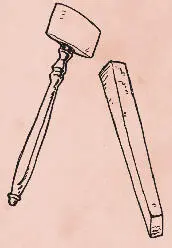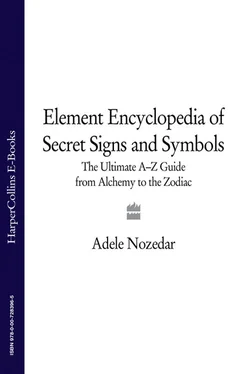Compasses work by turning on a central axle or pivot. This means that they are also a symbol of the Axis Mundi, of the circular nature of time, and of the ouroboros, the serpent which continually swallows its own tail.
There’s a common phrase, “on the square” or “on the level.” This means to be open, honest, proper, and above board, and springs directly from Masonic practice and ritual.
All the symbolism of the square and of the number 4 is applicable to this tool; it stands for solidity, respect, security.
4b. THE ANGLE OF THE COMPASS
Accounts differ as to whether the angle of the compass carries any special significance. The Masonic Compass is certainly drawn in different degrees. Some say that this represents the different degrees within Masonry, but again this is a matter for the inner sanctum of Masons.
Both the square and the compasses form a triangle, a symbol both of stability and of the spirit world.
Hidden within the square and compasses symbol is another magical sign, the Seal of Solomon, the hexagram or six-pointed star. This can be made if a line is drawn across the open point of the square and compasses. The seal is formed of two interlocking triangles and is one of the most ancient and universal magical symbols, also used in alchemy. Among other meanings, this star can be interpreted to mean “as above, so below.”
This does not always feature in the symbol of the compass and the square, and when it does there is ambivalence as to its meaning. Some say that it stands for God, others argue Geometry. Other interpretations including the notion that the G stands for Generation or possibly Government or even the Great Bear, the star that signifies the celestial pole or center, not only a physical center but a philosophical one. However, Masons agree that there is no definitive answer.
The legend of Hiram Abiff is the central core and inspiration for Freemasons. Hiram was a Master Mason who specialized in metalwork, and was one of the prime designers of the Temple of Solomon in Jerusalem. Here is the legend.
After the temple was completed, three of the other workers decided that they wanted to extract the secrets from Hiram that would qualify them to be Master Masons. They positioned themselves at the doors of the temple and individually demanded to know these secrets. Hiram refused each one in turn, telling them that the knowledge they desired could be gained only by experience. The three turned on Hiram and killed him; one struck a blow to his throat with a rule, the next hit him on the chest with an iron measuring square, and the third finished the job by hitting him on the forehead with a hammer. Full of remorse for the crime that they quickly realized was a fruitless murder, the “three ruffians,” as they came to be called, buried Hiram and placed an acacia tree over his grave.
However, although Hiram was effectively dead, his memory lives on and so effectively he is reborn. The initiation of the grade of Master Mason re-enacts the ritual of the death of Hiram. In as much as there are any hard and fast rules which apply to the symbolism inherent within Freemasonry, the three blows symbolize three different kinds of death: the death of the body (the blow to the throat), the death of the feelings (the strike on the chest), and the death of the mind (the blow to the forehead). Thus, the would-be Master Mason leaves his old self behind, the initiatory process symbolizing his rebirth into the higher moral values that were held by Hiram, of integrity, knowledge, and detachment. In other words, the mason is reborn as a better individual, having risen above the ignorance, hypocrisy, and envy personalized by his murderers.

The hammer, in use at Masonic meetings, is not used simply to gain the attention of the gathering. Effectively, it represents the powers of the intellect that drive the thoughts and the will of the individual. At Lodge meetings, the hammer is the symbol of the authority of the Worshipful Master who presides over the meeting.
The chisel is only useful if it is directed by the will of the hammer, and so represents the intellect and finer discernment.
Again, the level and the plumbline attached to it are inseparable items of practical building equipment that serve a deeper symbolic meaning within Freemasonry. The level comprises a set square, from the center of which hangs the plumbline. The plumbline is used to define both the vertical and horizontal lines, so it takes on the symbolism of the cross, too. The vertical level symbolizes the apprentice, and the horizontal, the degree of Fellowcraft.
It is also worth bearing in mind the philosophical meanings of the word “level,” meaning steady and honest, as well as its practical application as a tool. These two meanings are inextricably linked from the actual symbol of the tool itself.
Correct measurements, defined by the rule, are essential to the physical construction of a building, and ensure that the design concept will work in the real world. Also of significance are the degrees of measurement that are depicted on the actual ruler itself; in the imperial measurements, these degrees of 12 and 24 correspond to the daily cycle of the Sun. In this sense, the rule represents the macrocosm. The rule also keeps everything in order, and acts as a guide.
To Freemasons, the triangle symbolizes the Greek capital D, which they call the “shining Delta.” The triangle also indicates the meanings of things in triplicate, such as “right thinking, right speaking, and right doing.” On a microcosmic scale, the base of the triangle represents duration, and the two sides symbolize the qualities of light and darkness, male and female, etc. Possibly the most famous symbolic use of the Masonic triangle—which traditionally has an angle of 36 degrees at the apex and two angles of 72 degrees at the base—is the one that includes a blazing star and also a pentagram as seen on the Seal of the United States and on the United States dollar.
10. TRACING BOARD OR TRESTLE BOARD
As with many of the symbols inherent within Freemasonry, the tracing board itself is a symbolic representation of an important piece of practical equipment used in masonry.
The tracing, or trestle, board has its origins in the flat piece of wood or cloth that was used as a drawing board by the Master Mason, on which he sketched the dia-grams, schemes, and measurements needed for the building work in question. Initially represented as a piece of cloth which was rolled out on the floor at the beginning of a Masonic meeting, the tracing board is now a piece of wood that contains the signs and symbols relevant to the Brothers within their degrees of Masonic hierarchy. The boards are elaborate works of art, with the symbols woven into the whole in a pictorial, allegorical way. The symbols that are already mentioned in this section all take their place. The seemingly simple builders’ tools serve to remind the initiate of their more esoteric spiritual meanings that amount to the betterment of the person and personal enlightenment.
There are hundreds, if not thousands, of different sorts of tracing boards, all usually the work of individual artists. Different tracing boards show the different degrees of the Craft.
Читать дальше













